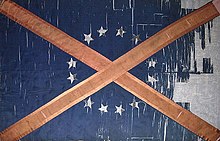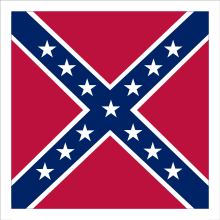This is an old revision of this page, as edited by Nemov (talk | contribs) at 17:57, 1 April 2022 (→Theories on origin: Changed verbiage. AG didn't issue a statement. It was in a letter to the Director of the Alabama Department of History and Archives.). The present address (URL) is a permanent link to this revision, which may differ significantly from the current revision.
Revision as of 17:57, 1 April 2022 by Nemov (talk | contribs) (→Theories on origin: Changed verbiage. AG didn't issue a statement. It was in a letter to the Director of the Alabama Department of History and Archives.)(diff) ← Previous revision | Latest revision (diff) | Newer revision → (diff) Flag of the U.S. state of Alabama
 | |
| Proportion | 2:3 |
|---|---|
| Adopted | February 16, 1895; 129 years ago (1895-02-16) |
| Design | St. Patrick's flag |
| Flag of the Governor of Alabama | |
 | |
| Design | The State Flag with the state military crest and Coat of Arms of Alabama in the lower and upper sections |
The current flag of Alabama (the second in Alabama state history) was adopted by Act 383 of the Alabama state legislature on February 16, 1895:
The flag of the State of Alabama shall be a crimson cross of St. Andrew on a field of white. The bars forming the cross shall be not less than six inches broad, and must extend diagonally across the flag from side to side." – (Code 1896, §3751; Code 1907, §2058; Code 1923, §2995; Code 1940, T. 55, §5.)
The cross of St. Andrew referred to in the law is a diagonal cross, known in vexillology as a saltire. Because the bars must be at least six inches (150 mm) wide, small representations of the Alabama flag do not meet the legal definition.
History
1861 flag

 Obverse (above) and reverse (below) of the 1861 flag
Obverse (above) and reverse (below) of the 1861 flag
On January 11, 1861, the Alabama Secession Convention passed a resolution designating an official flag. Designed by several women from Montgomery, final touches were made by Francis Corra of that city. One side of the flag displayed the Goddess of Liberty holding an unsheathed sword in her right hand; in her left she held a small blue flag with one gold star. Above the gold star appears the text "Alabama" in all capital letters. In an arch above this figure were the words "Independent Now and Forever". The reverse side of the flag had a cotton plant with a coiled rattlesnake. The text "Noli Me Tangere", ("Touch Me Not" in Latin), was placed below the cotton plant. This flag was flown until February 10, 1861, when it was removed to the Governor's Office after it was damaged by severe weather. It was never flown again.
Current flag


Alabama's current flag was adopted in 1895. The legislation introduced by Representative John W. A. Sanford Jr. stipulates that "he flag of the state of Alabama shall be a crimson cross of St. Andrew on a field of white. The bars forming the cross shall be not less than six inches broad, and must extend diagonally across the flag from side to side." St. Andrew's cross represents the cross on which St. Andrew was crucified.
The saltire of Alabama's flag most closely resembles the saltire of the flag of Florida, which was derived from the Spanish Cross of Burgundy. Southern Alabama was originally part of Spanish Florida and subsequently West Florida.
Alabama adopted its flag design in 1895, five years earlier than did Florida. But the 1868–1900 Seal of Florida already depicted a white flag with a red saltire. This is similar to Florida's current flag, or a Burgundian saltire; in the Florida flag, it is on top of a steamboat.
Theories on origin

No documentation in the legislative records indicates the flag was intended to commemorate the Confederacy. The local reporting at the time of the flag's adoption stated the Alabama flag was a suggestion of the Confederacy and another newspaper stating the flag had no historical connections. But, a few decades after the flag was adopted, several sources have said that the design was drawn from the battle flag. The authors of a 1917 article in National Geographic expressed their opinion that the Alabama flag was based on the Confederate Battle Flag. In 1924, Bell Allen Ross, a member of the Daughters of the Confederacy, said that John W.A. Sanford Jr. modeled his design of the Alabama flag on the battle flag used by his father, John W. A. Sanford commanding the Hilliard's Legion regiment. Sanford's design was meant to preserve some of the distinctive features of the Confederate battle flag, particularly the Saint Andrews Cross.
During the Civil War many battle flags were square, and the flag of Alabama is sometimes also depicted as square. The legislation that created the state flag did not specify that the flag was to be square but defined the width of the bars of the cross.
In 1987, the office of Alabama Attorney General Don Siegelman stated in a letter that the state flag was derived from the Confederate States Army's 60th Alabama Infantry Regiment battle flag. It also said that the proper shape of the state flag is rectangular, as it had been depicted numerous times in official publications and reproductions. Despite this, the flag is still often depicted as being square, even in official publications of the U.S. federal government.
Some commentators have interpreted the red saltire as a commemoration of Alabama's contributions to the Confederacy, since the flag was adopted during a period of promotion of the "Lost Cause" of the culture of the antebellum South. From the late 1870s, the white-dominated legislature passed Jim Crow laws and racial segregation. Other former Confederate slave states, beginning with Mississippi, and followed by Florida, had also adopted new state flags around the same time that they disenfranchised African Americans and passed laws establishing Jim Crow segregation.
But others, such as Steve Murray, Director of the Alabama Department of History and Archives, believe the origins are unclear. According to Murray, the flag's connections to the battle flag are thin and based on suppositions. Murray said, "I would conclude that if they were wanting to evoke the Confederate battle flag, they would have been more explicit about doing it either in the design which could have more closely resembled the Confederate flag." Murray also noted that Alabama may have wanted to approve a new state flag to prepare for an exposition in Atlanta, Georgia later that year.
Governor's flag
See also: Flags of governors of the U.S. statesThe flag of the governor of Alabama is a variant of the state flag. In the top saltire, the flag displays the state coat of arms. The bottom saltire contains the state military crest, which consists of a cotton plant with full bursting boll.
See also
References
- "Official Symbols and Emblems of Alabama: State Flag of Alabama". Alabama Department of Archives & History. Retrieved June 15, 2012.
- Robert B. Bradley (2000). "Flags of the Confederacy – Flags of Alabama". Flags of the Confederacy. Flags of the Confederacy. Retrieved November 17, 2007.
- ^ Alabama Department of Archives & History (2001). "The Secession Convention Flag". Retrieved November 17, 2007.
- Code of 69 (1975) § 1-2-5
- ^ "Alabama's Red Cross Flag". New York Times. March 28, 1906. Retrieved March 28, 2022.
- ^ Mignanelli, Nicholas; Slinger, Sarah (2020). "A Matter for Interpretation: An Inquiry into Confederate Symbolism and the Florida State Flag". University of Miami Race and Social Justice Law Review. 10 (2): 126–129, 134–137. Retrieved March 26, 2022.
- https://www.newspapers.com/image/348936621/?terms=%22state%20flag%22%20%22battle%20flag%22&match=1
- Williams, Dave (September 17, 2000). "Flag debate spreading across Deep South". Savannah Morning News. Archived from the original on July 22, 2015. Retrieved March 25, 2022.
- *Lt. Commander Byron McCandless & Gilbert Grosvenor. "Flags of the World." National Geographic Magazine. Vol 32. No. 4, pp. 281–420 (October 1917).
- Alabama Department of Archives & History (2007). "Flag: Hilliard's Legion". Retrieved March 28, 2022.
- "Interesting Facts Regarding Alabama Flag". Anniston Star. December 14, 1924. Retrieved March 28, 2022.
- Alabama Department of Archives & History (2007). "State Flag of Alabama". Retrieved November 17, 2007.
- Don Siegelman (1987). "Opinion of Don Siegelman" (PDF). Office of the Attorney General of the State of Alabama. Archived from the original (PDF) on April 14, 2008. Retrieved November 17, 2007.
- "Our Flag" (PDF). U.S. Government Printing Office. 2007. Archived from the original (PDF) on August 5, 2010.
- Ingraham, Christopher (June 21, 2015). "How the Confederacy lives on in the flags of seven Southern states". Washington Post. Retrieved March 25, 2022.
- ^ Coski, John M. (2005). The Confederate Battle Flag: America's Most Embattled Emblem. United States of America: First Harvard University Press. pp. 79–81. ISBN 0-674-01983-0. Archived from the original on March 9, 2016. Retrieved March 25, 2022.
The flag changes in Mississippi, Alabama, and Florida coincided with the passage of formal Jim Crow segregation laws throughout the South. Four years before Mississippi incorporated a Confederate battle flag into its state flag, its constitutional convention passed pioneering provisions to 'reform' politics by effectively disenfranchising most African Americans.
- ^ "Historical record thin on specifics regarding Alabama's flag design". WAFF (TV). June 30, 2020. Retrieved March 28, 2022.
External links
- Alabama State Flag at the Alabama Department of Archives & History
- written account of the flag in 1987 by Don Siegelman, Alabama Attorney General

